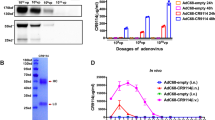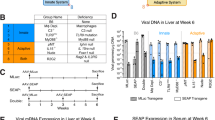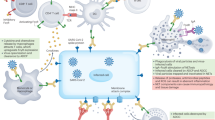Abstract
Human complement receptors 1 and 2 are well described as important regulators of innate and adaptive immune responses, having pivotal roles in regulating complement activation (CR1) and B-cell maturation/survival. In contrast, the role of the murine homologs of CR1 and CR2 (mCR1/2) have been primarily defined as modulating activation of the adaptive immune system, with very little evidence available about the role of mCR1/2 in regulating the innate immune responses to pathogens. In this paper, we confirm that mCR1/2 plays an important role in regulating both the innate and adaptive immune responses noted after Adenovirus (Ad)-mediated gene transfer. Our results uncovered a novel role of mCR1/2 in downregulating several complement-dependent innate immune responses. We also unveiled the mechanism underlying the complement-dependent induction of neutralizing antibodies to Ad capsids as a CR1/2-dependent phenomenon that correlates with B-cell activation. These results confirm that Ad interactions with the complement system are pivotal in understanding how to maximize the safety or potency of Ad-mediated gene transfer for both gene therapy and vaccine applications.
This is a preview of subscription content, access via your institution
Access options
Subscribe to this journal
Receive 12 print issues and online access
$259.00 per year
only $21.58 per issue
Buy this article
- Purchase on Springer Link
- Instant access to full article PDF
Prices may be subject to local taxes which are calculated during checkout







Similar content being viewed by others
References
Appledorn DM, McBride A, Seregin S, Scott JM, Schuldt N, Kiang A et al. Complex interactions with several arms of the complement system dictate innate and humoral immunity to adenoviral vectors. Gene Therapy 2008; 15: 1606–1617.
Zhu J, Huang X, Yang Y . Type I IFN signaling on both B and CD4 T cells is required for protective antibody response to adenovirus. J Immunol 2007; 178: 3505–3510.
Carlisle RC, Di Y, Cerny AM, Sonnen AF, Sim RB, Green NK et al. Human erythrocytes bind and inactivate type 5 adenovirus by presenting Coxsackie virus-adenovirus receptor and complement receptor 1. Blood 2009; 113: 1909–1918.
Muruve DA, Petrilli V, Zaiss AK, White LR, Clark SA, Ross PJ et al. The inflammasome recognizes cytosolic microbial and host DNA and triggers an innate immune response. Nature 2008; 452: 103–107.
Xu Z, Tian J, Smith JS, Byrnes AP . Clearance of adenovirus by Kupffer cells is mediated by scavenger receptors, natural antibodies, and complement. J Virol 2008; 82: 11705–11713.
Gasque P . Complement: a unique innate immune sensor for danger signals. Mol Immunol 2004; 41: 1089–1098.
Kawano M . Complement regulatory proteins and autoimmunity. Arch Immunol Ther Exp 2000; 48: 367–372.
Morgan BP, Marchbank KJ, Longhi MP, Harris CL, Gallimore AM . Complement: central to innate immunity and bridging to adaptive responses. Immunol Lett 2005; 97: 171–179.
Kemper C, Atkinson JP . T-cell regulation: with complements from innate immunity. Nat Rev 2007; 7: 9–18.
Prechl J, Erdei A . Immunomodulatory functions of murine CR1/2. Immunopharmacology 2000; 49: 117–124.
Tedder TF, Inaoki M, Sato S . The CD19-CD21 complex regulates signal transduction thresholds governing humoral immunity and autoimmunity. Immunity 1997; 6: 107–118.
Tedder TF, Haas KM, Poe JC . CD19-CD21 complex regulates an intrinsic Src family kinase amplification loop that links innate immunity with B-lymphocyte intracellular calcium responses. Biochem Soc Trans 2002; 30: 807–811.
Carroll MC . The complement system in B cell regulation. Mol Immunol 2004; 41: 141–146.
Boackle SA, Holers VM, Karp DR . CD21 augments antigen presentation in immune individuals. Eur J Immunol 1997; 27: 122–129.
Holers VM, Kulik L . Complement receptor 2, natural antibodies and innate immunity: inter-relationships in B cell selection and activation. Mol Immunol 2007; 44: 64–72.
Fairweather D, Frisancho-Kiss S, Njoku DB, Nyland JF, Kaya Z, Yusung SA et al. Complement receptor 1 and 2 deficiency increases coxsackievirus B3-induced myocarditis, dilated cardiomyopathy, and heart failure by increasing macrophages, IL-1beta, and immune complex deposition in the heart. J Immunol 2006; 176: 3516–3524.
Haas KM, Hasegawa M, Steeber DA, Poe JC, Zabel MD, Bock CB et al. Complement receptors CD21/35 link innate and protective immunity during Streptococcus pneumoniae infection by regulating IgG3 antibody responses. Immunity 2002; 17: 713–723.
Appledorn DM, Kiang A, McBride A, Jiang H, Seregin S, Scott JM et al. Wild-type adenoviruses from groups A-F evoke unique innate immune responses, of which HAd3 and SAd23 are partially complement dependent. Gene Therapy 2008; 15: 885–901.
Hartman ZC, Appledorn DM, Amalfitano A . Adenovirus vector induced innate immune responses: impact upon efficacy and toxicity in gene therapy and vaccine applications. Virus Res 2008; 132: 1–14.
Hartman ZC, Kiang A, Everett RS, Serra D, Yang XY, Clay TM et al. Adenovirus infection triggers a rapid, MyD88-regulated transcriptome response critical to acute-phase and adaptive immune responses in vivo. J Virol 2007; 81: 1796–1812.
Kiang A, Hartman ZC, Everett RS, Serra D, Jiang H, Frank MM et al. Multiple innate inflammatory responses induced after systemic adenovirus vector delivery depend on a functional complement system. Mol Ther 2006; 14: 588–598.
Li Y, Muruve DA, Collins RG, Lee SS, Kubes P . The role of selectins and integrins in adenovirus vector-induced neutrophil recruitment to the liver. Eur J Immunol 2002; 32: 3443–3452.
Liu Q, Zaiss AK, Colarusso P, Patel K, Haljan G, Wickham TJ et al. The role of capsid-endothelial interactions in the innate immune response to adenovirus vectors. Hum Gene Ther 2003; 14: 627–643.
Schiedner G, Hertel S, Kochanek S . Efficient transformation of primary human amniocytes by E1 functions of Ad5: generation of new cell lines for adenoviral vector production. Hum Gene Ther 2000; 11: 2105–2116.
Miwa K, Igawa A, Inoue H . Soluble E-selectin, ICAM-1 and VCAM-1 levels in systemic and coronary circulation in patients with variant angina. Cardiovasc Res 1997; 36: 37–44.
Raper SE, Chirmule N, Lee FS, Wivel NA, Bagg A, Gao GP et al. Fatal systemic inflammatory response syndrome in a ornithine transcarbamylase deficient patient following adenoviral gene transfer. Mol Genet Metab 2003; 80: 148–158.
Manickan E, Smith JS, Tian J, Eggerman TL, Lozier JN, Muller J et al. Rapid Kupffer cell death after intravenous injection of adenovirus vectors. Mol Ther 2006; 13: 108–117.
Cotter MJ, Zaiss AK, Muruve DA . Neutrophils interact with adenovirus vectors via Fc receptors and complement receptor 1. J Virol 2005; 79: 14622–14631.
Hu H, Serra D, Amalfitano A . Persistence of an [E1-, polymerase-] adenovirus vector despite transduction of a neoantigen into immune-competent mice. Hum Gene Ther 1999; 10: 355–364.
Everett RS, Hodges BL, Ding EY, Xu F, Serra D, Amalfitano A . Liver toxicities typically induced by first-generation adenoviral vectors can be reduced by use of E1, E2b-deleted adenoviral vectors. Hum Gene Ther 2003; 14: 1715–1726.
Hartman ZC, Black EP, Amalfitano A . Adenoviral infection induces a multi-faceted innate cellular immune response that is mediated by the toll-like receptor pathway in A549 cells. Virology 2007; 358: 357–372.
Zinn KR, Szalai AJ, Stargel A, Krasnykh V, Chaudhuri TR . Bioluminescence imaging reveals a significant role for complement in liver transduction following intravenous delivery of adenovirus. Gene Therapy 2004; 11: 1482–1486.
Hawlisch H, Kohl J . Complement and Toll-like receptors: key regulators of adaptive immune responses. Mol Immunol 2006; 43: 13–21.
Carroll M . Role of complement receptors CD21/CD35 in B lymphocyte activation and survival. Curr Top Microbiol Immunol 1999; 246: 63–68; discussion 69.
Sato S, Miller AS, Howard MC, Tedder TF . Regulation of B lymphocyte development and activation by the CD19/CD21/CD81/Leu 13 complex requires the cytoplasmic domain of CD19. J Immunol 1997; 159: 3278–3287.
Miwa T, Song WC . Membrane complement regulatory proteins: insight from animal studies and relevance to human diseases. Int Immunopharmacol 2001; 1: 445–459.
Miwa T, Zhou L, Tudoran R, Lambris JD, Madaio MP, Nangaku M et al. DAF/Crry double deficiency in mice exacerbates nephrotoxic serum-induced proteinuria despite markedly reduced systemic complement activity. Mol Immunol 2007; 44: 139–146.
Turnberg D, Botto M . The regulation of the complement system: insights from genetically-engineered mice. Mol Immunol 2003; 40: 145–153.
Moser B, Willimann K . Chemokines: role in inflammation and immune surveillance. Ann Rheum Dis 2004; 63 (Suppl 2): ii84–ii89.
Zaiss AK, Cotter MJ, White LR, Clark SA, Wong NC, Holers VM et al. Complement is an essential component of the immune response to adeno-associated virus vectors. J Virol 2008; 82: 2727–2740.
Tian J, Xu Z, Smith JS, Hofherr SE, Barry MA, Byrnes AP . Adenovirus activates complement by distinctly different mechanisms in vitro and in vivo: indirect complement activation by virions in vivo. J Virol 2009; 83: 5648–5658.
Croyle MA, Chirmule N, Zhang Y, Wilson JM . “Stealth” adenoviruses blunt cell-mediated and humoral immune responses against the virus and allow for significant gene expression upon readministration in the lung. J Virol 2001; 75: 4792–4801.
Ricklin D, Lambris JD . Compstatin: a complement inhibitor on its way to clinical application. Adv Exp Med Biol 2008; 632: 273–292.
Green TD, Newton BR, Rota PA, Xu Y, Robinson HL, Ross TM . C3d enhancement of neutralizing antibodies to measles hemagglutinin. Vaccine 2001; 20: 242–248.
Ross TM, Xu Y, Bright RA, Robinson HL . C3d enhancement of antibodies to hemagglutinin accelerates protection against influenza virus challenge. Nat Immunol 2000; 1: 127–131.
Draper SJ, Moore AC, Goodman AL, Long CA, Holder AA, Gilbert SC et al. Effective induction of high-titer antibodies by viral vector vaccines. Nat Med 2008; 14: 819–821.
Ogun SA, Dumon-Seignovert L, Marchand JB, Holder AA, Hill F . The oligomerization domain of C4-binding protein (C4bp) acts as an adjuvant, and the fusion protein comprised of the 19-kilodalton merozoite surface protein 1 fused with the murine C4bp domain protects mice against malaria. Infect Immun 2008; 76: 3817–3823.
Ricklin D, Lambris JD . Complement-targeted therapeutics. Nat Biotechnol 2007; 25: 1265–1275.
Hodges BL, Evans HK, Everett RS, Ding EY, Serra D, Amalfitano A . Adenovirus vectors with the 100K gene deleted and their potential for multiple gene therapy applications. J Virol 2001; 75: 5913–5920.
Ng P, Graham FL . Construction of first-generation adenoviral vectors. Methods Mol Med 2002; 69: 389–414.
Amalfitano A, Hauser MA, Hu H, Serra D, Begy CR, Chamberlain JS . Production and characterization of improved adenovirus vectors with the E1, E2b, and E3 genes deleted. J Virol 1998; 72: 926–933.
Gommerman JL, Oh DY, Zhou X, Tedder TF, Maurer M, Galli SJ et al. A role for CD21/CD35 and CD19 in responses to acute septic peritonitis: a potential mechanism for mast cell activation. J Immunol 2000; 165: 6915–6921.
Hensley SE, Cun AS, Giles-Davis W, Li Y, Xiang Z, Lasaro MO et al. Type I interferon inhibits antibody responses induced by a chimpanzee adenovirus vector. Mol Ther 2007; 15: 393–403.
Hofstetter JR, Zhang A, Mayeda AR, Guscar T, Nurnberger Jr JI, Lahiri DK . Genomic DNA from mice: a comparison of recovery methods and tissue sources. Biochem Mol Med 1997; 62: 197–202.
Loniewski KJ, Patial S, Parameswaran N . Sensitivity of TLR4- and -7-induced NF kappa B1 p105-TPL2-ERK pathway to TNF-receptor-associated-factor-6 revealed by RNAi in mouse macrophages. Mol Immunol 2007; 44: 3715–3723.
Acknowledgements
We thank Michigan State University Laboratory Animal support facility for their assistance in the humane care and maintenance of the animals utilized in this work and Michigan State University Investigative Histopathology Laboratory for performing H&E stains of liver tissues. SSS was supported by American Heart Association Midwest Affiliate Fellowship 0815660G. AA was supported by the National Institutes of Health grants RO1DK-069884, P01 CA078673, the MSU Foundation as well the Osteopathic Heritage Foundation.
Author information
Authors and Affiliations
Corresponding author
Additional information
Supplementary Information accompanies the paper on Gene Therapy website (http://www.nature.com/gt)
Rights and permissions
About this article
Cite this article
Seregin, S., Aldhamen, Y., Appledorn, D. et al. CR1/2 is an important suppressor of Adenovirus-induced innate immune responses and is required for induction of neutralizing antibodies. Gene Ther 16, 1245–1259 (2009). https://doi.org/10.1038/gt.2009.77
Received:
Revised:
Accepted:
Published:
Issue Date:
DOI: https://doi.org/10.1038/gt.2009.77



